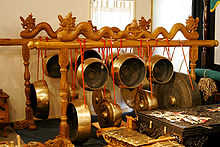Gong ageng
Gong ageng , high Javanese ( krama ), "big gong", in Javanese vernacular ( ngoko ) gong gede , is the largest hanging gong in some orchestral formations ( gamelan ) on the Indonesian islands of Java and Bali .
Design
Gongs are idiophones . A gong ageng is made of bronze and has a protruding hump in the middle and an edge that is curved backwards. It is usually between 79 and 96 cm in diameter. The gong ageng usually hangs in a wooden frame richly decorated with carvings. The instrument is struck with a round, padded mallet. If you strike different parts of the gong, different sounds are produced. The gong ageng produces a deep and long lasting sound.
Style of play
The gong ageng is the largest gong in the gamelan of Javanese and Balinese music , as well as in the music of Lombok . It marks the end of the longest musical unit called gongan . He is understood as a “father” or “master of gamelan”. Its role in the orchestra is to clarify the structure of a piece and, for example, to mark the end of a cyclical section. In Balinese Gamelan Gong Kebyar , the slightly larger of the gongs played in pairs in the function of gong ageng is called gong wadon ("female gong"), while the slightly smaller gong lanang ("male gong") is called.
The gong suwukan is smaller than the gong ageng , with a diameter of 50 to 60 cm, and again smaller and sounding an octave higher than the kempul . Even smaller hanging gongs are penotong , followed by bendé and gong bèri . The smallest hanging gongs are called engkuk and kemong . They all mark different time units and complement each other to form a cyclical melody.
literature
- Jaap Art : Music in Java. Its History, its Theory and its Technique . 3rd edition edited by Ernst L. Heins. Volume 1. Martinus Nijhoff, Den Haag 1973, pp. 136-142
Web links
- Gong Ageng. seasite.niu.edu (English)
- Lydia Ayers, Andrew Horner: Synthesizing Music in Csound with a Javanese Gong Ageng. 2005
